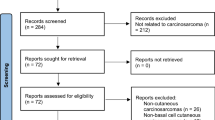Abstract
Basal Cell Carcinoma (BCC) is the most prevalent skin cancer and continues to witness a surge in incidence rates. The categorization of BCC subtypes into low or high risk, guided by recurrence and invasiveness metrics, underscores the need for precise differentiation. While the punch biopsy remains the gold standard for diagnosis, its invasiveness prompts a need for non-invasive alternatives. Ultrasound (US) has emerged as a noteworthy candidate, gaining momentum in its potential to offer a less intrusive diagnostic approach. We conducted a systematic review regarding features of the high-risk subtypes of BCC on US. A thorough literature search of PubMed Medline, Embase, and CINAHL databases was conducted according to PRISMA guidelines and a total of nine studies meeting our inclusion criteria were included in this review. Evidence is still nascent but US features such as lesional shape, depth, hyperechoic spots, and color doppler may be helpful in differentiating high-risk BCC subtypes. However, further prospective studies with standardized interventions and outcome measures are required.

Similar content being viewed by others
Data availability
No datasets were generated or analysed during the current study.
References
Alfageme F, Salgüero I, Nájera L, Suarez ML, Roustan G (2019) Increased marginal stiffness differentiates infiltrative from noninfiltrative cutaneous basal cell carcinomas in the facial area: a prospective study. J Ultrasound Med 38(7):1841–1845. https://doi.org/10.1002/jum.14880
Bobadilla F, Wortsman X, Muñoz C, Segovia L, Espinoza M, Jemec GB (2008) Pre-surgical high resolution ultrasound of facial basal cell carcinoma: correlation with histology. Cancer Imaging 8(1):163–172 Published 2008 Sep 22. https://doi.org/10.1102/1470-7330.2008.0026
Cameron MC, Lee E, Hibler BP et al (2021) Basal cell carcinoma: Epidemiology; pathophysiology; clinical and histological subtypes; and disease associations [published correction appears in J Am Acad Dermatol. ;85(2):535]0. J Am Acad Dermatol. 2019;80(2):303–317. https://doi.org/10.1016/j.jaad.2018.03.060
Chauvel-Picard J, Tognetti L, Cinotti E et al (2023) Role of ultra-high-frequency ultrasound in the diagnosis and management of basal cell carcinoma: pilot study based on 117 cases. Clin Exp Dermatol 48(5):468–475. https://doi.org/10.1093/ced/llad001
Hernández-Ibáñez C, Aguilar-Bernier M, Fúnez-Liébana R, Del Boz J, Blázquez N, de Troya M (2014) The usefulness of high-resolution ultrasound in detecting invasive disease in recurrent basal cell carcinoma after nonsurgical treatment. Actas Dermosifiliogr 105(10):935–939. https://doi.org/10.1016/j.ad.2014.05.002
Hernández-Ibáñez C, Blazquez-Sánchez N, Aguilar-Bernier M, Fúnez-Liébana R, Rivas-Ruiz F, de Troya-Martín M (2017) Usefulness of high-frequency Ultrasound in the classification of histologic subtypes of primary basal cell carcinoma. Actas Dermosifiliogr 108(1):42–51. https://doi.org/10.1016/j.ad.2016.08.002
Kamyab-Hesari K, Seirafi H, Naraghi ZS et al (2014) Diagnostic accuracy of punch biopsy in subtyping basal cell carcinoma. J Eur Acad Dermatol Venereol 28(2):250–253. https://doi.org/10.1111/j.1468-3083.2012.04695.x
Laverde-Saad A, Simard A, Nassim D et al (2022) Performance of Ultrasound for identifying morphological characteristics and thickness of cutaneous basal cell carcinoma: a systematic review. Dermatology 238(4):692–710. https://doi.org/10.1159/000520751
Liang JF, Luo PP, Zhang Y, Zhao G, Zhou M, Wang J (2023) Comparison of Sonographic characteristics between superficial basal cell carcinoma and non-superficial basal cell carcinomas. J Ultrasound Med 42(7):1549–1556. https://doi.org/10.1002/jum.16174
Marzuka AG, Book SE (2015) Basal cell carcinoma: pathogenesis, epidemiology, clinical features, diagnosis, histopathology, and management. Yale J Biol Med 88(2):167–179 Published 2015 Jun 1
Roozeboom MH, Mosterd K, Winnepenninckx VJ, Nelemans PJ, Kelleners-Smeets NW (2013) Agreement between histological subtype on punch biopsy and surgical excision in primary basal cell carcinoma. J Eur Acad Dermatol Venereol. ;27(7):894–898. https://doi.org10.1111/j.1468-3083.2012.04608.x
Siskou S, Pasquali P, Trakatelli M (2023) High frequency ultrasound of basal cell carcinomas: Ultrasonographic Features and histological subtypes, a retrospective study of 100 tumors. J Clin Med 12(12):3893 Published 2023 Jun 7. https://doi.org/10.3390/jcm12123893
Trakatelli M, Morton C, Nagore E et al (2014) Update of the European guidelines for basal cell carcinoma management. Eur J Dermatol 24(3):312–329. https://doi.org/10.1684/ejd.2014.2271
Uhara H, Hayashi K, Koga H, Saida T (2007) Multiple hypersonographic spots in basal cell carcinoma. Dermatol Surg 33(10):1215–1219. https://doi.org/10.1111/j.1524-4725.2007.33256.x
Vega N, Wortsman X, Navarrete N, Sazunic I (2018) Color Doppler Ultrasound supports early diagnosis of mixed high and low risk of recurrence subtypes in the same basal cell carcinoma lesion. Dermatol Surg 44(5):741–743. https://doi.org/10.1097/DSS.0000000000001328
Wang SQ, Liu J, Zhu QL et al (2019) High-frequency ultrasound features of basal cell carcinoma and its association with histological recurrence risk. Chin Med J (Engl) 132(17):2021–2026. https://doi.org/10.1097/CM9.0000000000000369
Wang LF, Zhu AQ, Wang Q et al (2021) Value of high-frequency Ultrasound for differentiating invasive basal cell carcinoma from non-invasive types. Ultrasound Med Biol 47(10):2910–2920. https://doi.org/10.1016/j.ultrasmedbio.2021.06.006
Whiting P, Rutjes AW, Reitsma JB, Bossuyt PM, Kleijnen J (2003) The development of QUADAS: a tool for the quality assessment of studies of diagnostic accuracy included in systematic reviews. BMC Med Res Methodol 3:25 Published 2003 Nov 10. https://doi.org/10.1186/1471-2288-3-25
Work Group, Invited Reviewers, Kim JYS et al (2018) Guidelines of care for the management of basal cell carcinoma. J Am Acad Dermatol 78(3):540–559. https://doi.org/10.1016/j.jaad.2017.10.006
Wortsman X, Vergara P, Castro A et al (2015) Ultrasound as predictor of histologic subtypes linked to recurrence in basal cell carcinoma of the skin. J Eur Acad Dermatol Venereol 29(4):702–707. https://doi.org/10.1111/jdv.12660
Funding
No funding was received.
Author information
Authors and Affiliations
Contributions
All authors contributed to the origination of the idea. R.K. and A.A. conducted the literature search, screening, and drafted the work. A.K. revised the work. All authors reviewed the manuscript.
Corresponding author
Ethics declarations
Competing interests
The authors declare no competing interests.
Additional information
Publisher’s Note
Springer Nature remains neutral with regard to jurisdictional claims in published maps and institutional affiliations.
Electronic supplementary material
Below is the link to the electronic supplementary material.
Rights and permissions
Springer Nature or its licensor (e.g. a society or other partner) holds exclusive rights to this article under a publishing agreement with the author(s) or other rightsholder(s); author self-archiving of the accepted manuscript version of this article is solely governed by the terms of such publishing agreement and applicable law.
About this article
Cite this article
Khan, R., Ahmed, A. & Khachemoune, A. Ultrasound features of high-risk basal cell carcinoma: a systematic review. Arch Dermatol Res 316, 210 (2024). https://doi.org/10.1007/s00403-024-02949-7
Received:
Revised:
Accepted:
Published:
DOI: https://doi.org/10.1007/s00403-024-02949-7




